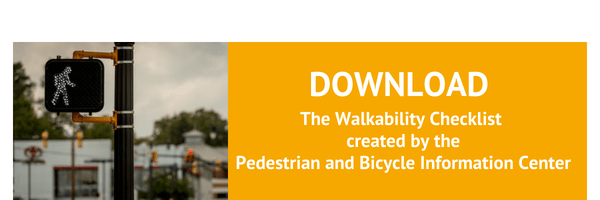Do You Live in a Walkable Neighborhood?
We know how it feels to walk in interesting, people-friendly places and how it feels to walk in a place designed primarily for cars. But how can we measure that feeling? Learn about Walkability Checklists.
When you think about a walkable place, what comes to mind? A bustling shopping district like Clarendon? The Mount Vernon Trail? Your neighborhood? A highway like I-395?
Wherever place you thought of, it’s unlikely that it was a highway like I-395! Despite our different preferences, abilities, and comfort levels with walking, there are places that are understood to be more walkable than others. Older neighborhoods and downtown areas are generally more walkable than high-speed roadways. But what makes these places feel this way?

What is the Definition of Walkability?
Walkability is how friendly a place is to walk. A walkable place is pleasant, safe, and comfortable for people walking (and most likely for people biking and taking transit, too) and has some of the following characteristics:
- Sidewalks
- Crosswalks and other crossing infrastructure
- People-scaled buildings and interesting things to see at the street level
- Seating or places to rest
- Comfortable and safe for people of all ages and abilities
- Lighting
- Destinations and things to do, eat, drink, buy, and enjoy
- Wayfinding and signage
- Low vehicle speeds or few vehicles
- Separation of people walking from moving vehicles (e.g., grass medians)
- The presence of other people
Measure Walkability in Your Neighborhood
One way to measure walkability yourself is to use a Walkability Checklist, created by the Pedestrian and Bicycle Information Center (PBIC) and adapted by AARP. The Checklist asks questions to help you identify things in your neighborhood or on your street that may act as a barrier to safe, enjoyable walking, including how easy it is to cross a street or whether there are curb ramps. Your findings can also lead to meaningful change.
How to Complete a Walkability Checklist
- Take a copy of the Walkability Checklist with you.
- Select a place to walk, such as from your home to the nearest grocery store or a friend’s house.
*PBIC suggests going on a walk with a child as part of assessing their walk to school, but it can be done with anyone at any age. - Review the checklist and make note of the things you see as you walk and give each question a rating.
- Add up your score to see how your neighborhood performs.
Engage Your Community
Taking a walk and completing the Checklist is a great neighborhood or community association activity. It can help those who don’t walk often to experience walking firsthand and creates a shared understanding of various safety problems or uncomfortable areas that need to be improved. It can also highlight some of the positive walk-friendly things about your neighborhood.
The results of the Walkability Checklist will help you facilitate discussions with neighborhood associations, transportation departments, and elected officials about the places that are not walkable and missing walk-friendly elements with the goal of implementing changes that lead to safe walking in your community.
This post was updated on November 12, 2019.
Sam Kittner/Kittner.com










Comments are closed here.
To prevent spam, comments will be approved before appearing on the post. If you have a comment or question, but do not want it to be published, please email WalkArlington.